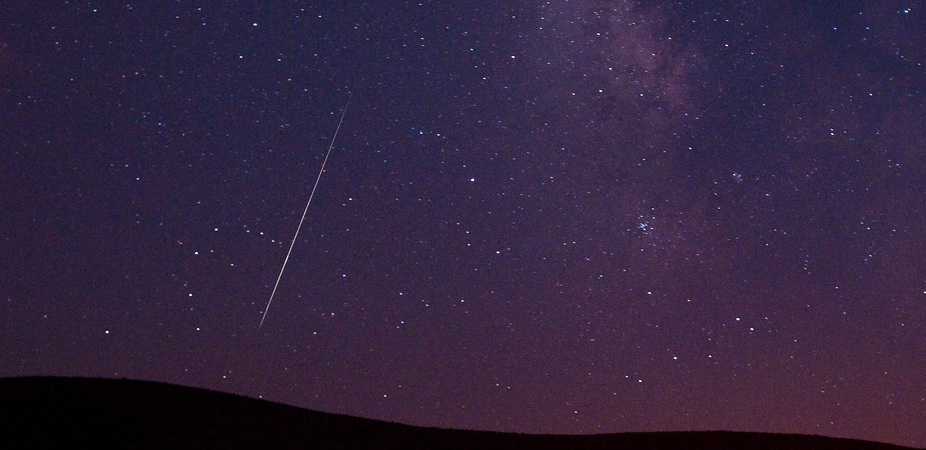
Your House is Full of Space Dust – It Reveals the Solar System's Story (Op-Ed)

This article was originally published at The Conversation. The publication contributed the article to SPACE.com's Expert Voices: Op-Ed & Insights.
When you clean your house you are probably vacuuming up space dust. Not kidding. It is the same dust that was once part of comets and asteroids. You see that dust in the faint glow it helps create before sunrise and after sunset. As much as 40,000 tons of space dust arrives on Earth every year.
While that fact may not be in doubt, there is a lot of debate about where this dust comes from. Most of it, we know, spirals down from the interplanetary dust cloud, a vast swathe of dust extending in a disk-shape around the sun. But where exactly did this dust cloud originate?
Recent studies suggest that less than 10% of the dust comes from asteroids, but that a much larger portion originates from Jupiter-family comets. These comets, which are made up of ice and dust, orbit around the sun close to Jupiter. They most likely enter the inner solar system because of collisions with other comets in the Kuiper belt, a major comet belt found beyond Neptune.
When space dust falls to Earth, depending on its size and abundance, it can produce a meteor shower (shooting stars). In fact, the annual Perseids and Leonids meteor showers are produced by the Earth encountering the dusty debris left behind from comets Swift-Tuttle and Tempel-Tuttle. Comet dust travels at high speeds, sometimes more than 150,000kph. It is slowed by the Earth’s atmosphere, but the pressure created on bigger pieces is enough to cause it to burn up in a flash of light. Smaller particles are the lucky ones. They can deal with the sudden change in pressure when entering Earth’s atmosphere and make it all the way to the surface.
NASA regularly uses special ER2 aircraft, a research version of the U2 spy plane, to fly at stratospheric heights (around 20km, twice that of a commercial plane) to collect space dust. The collection technique itself is simple. When at cruising altitude in the stratosphere the pilot opens up some pods below the wing containing “sticky pads”, which collect pieces of space dust. Back on Earth NASA use an exceptionally clean laboratory to pick the space dust from the collectors for researchers, like myself, to study.
My research is based around these dust particles because they offer our best opportunity to sample comets. The ER2 is a much cheaper way of obtaining these samples. The other method involves launching a spacecraft to reach out to a comet, and ensuring it can come back after passing through a comet’s icy and dusty tail, or even landing on its surface. There has been only one comet sample return mission to date – NASA’s Stardust.
Get the Space.com Newsletter
Breaking space news, the latest updates on rocket launches, skywatching events and more!
Such missions, despite their expense, provide the most pristine solar system samples we will ever get. The spacecraft acts like a cocoon, protecting the samples on their travel through space, and from the extreme heating effects of entering the Earth’s atmosphere that can otherwise cause irreversible changes to the sample.
Comets contain the initial dust that formed our solar system, and, because they stayed far away from the sun for most of their lives, they act as a deep freeze, preserving dust that is billions of years old. By studying this dust we can effectively travel back in time to the start of the solar system to understand the composition of everything we know, including early-formed organic matter and water.
Organic matter – chemical compounds containing carbon-hydrogen bonds – is actually ubiquitous throughout the universe. One of the big questions is whether organic compounds can be delivered to planets to form the basis for life. We are still not sure how life started on Earth. If this did happen, comets and asteroids are good candidates as a transport vehicle.
The same story applies to water. We clearly have a lot of it on Earth but understanding if it came from asteroid or comet collisions with Earth, or if it was present in Earth from the start, is a question we can try to answer with comet samples.
In a recent study, I measured different forms of the elements hydrogen, carbon, nitrogen and oxygen in the cometary dust samples collected by NASA. The relationships between these different elements reveal information about where the comet formed in relation to the sun. They also tell us what kind of life the comet has had. For instance, if it was ever subjected to high temperatures, that would tell us if it had travelled near to the sun.
These dust samples add a few pieces to our complicated jigsaw of the solar system, helping us to understand when and where the planets formed, and how water and organic matter fit into the picture. We will never complete the jigsaw in my lifetime but continued analysis of samples returned from the depths of the solar system will help us make progress to figuring out where we came from.
Natalie Starkey receives funding from The Science and Technology Facilities Council. She is affiliated with Planetary and Space Sciences at The Open University.
This article was originally published at The Conversation. Read the original article. The views expressed are those of the author and do not necessarily reflect the views of the publisher. This version of the article was originally published on SPACE.com.
Join our Space Forums to keep talking space on the latest missions, night sky and more! And if you have a news tip, correction or comment, let us know at: community@space.com.










